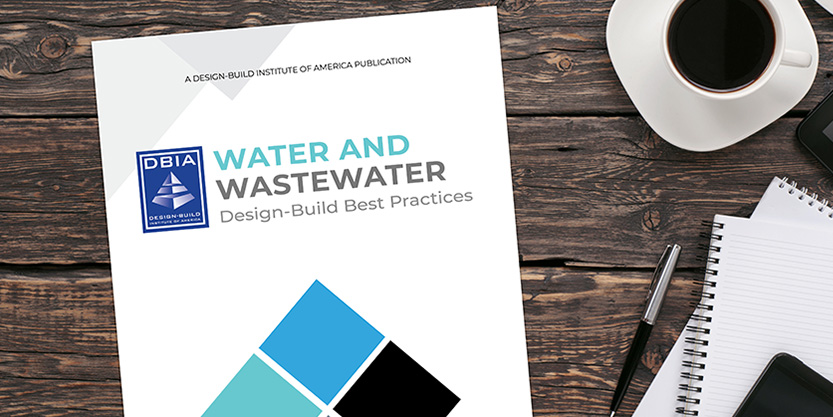
DBIA is excited to announce the release of our new Water/Wastewater Best Practices document. This guide builds on DBIA’s Universal Best Practices, aiding professionals in the water and wastewater sector in navigating the challenges of their projects with greater efficiency and success. By addressing the specific needs of this vital sector, targeted Best Practices support the delivery of high-quality design-build projects that prioritize public health and safety.
A subgroup of DBIA’s Water/Wastewater Markets Committee, led by Chair David Hill, DBIA, Ferguson Waterworks, and Co-Chair Drew Zirkle, PE, DBIA, HDR, worked with a diverse team of seasoned experts and partner organizations to update these best practices by drawing from their extensive experience in water and wastewater design-build projects.
“I extend a sincere thank you to the Water/Wastewater Best Practices Subcommittee members for their diversity of thought, experience and extended contributions on these best practices,” said Hill.
“The ever-increasing demands of water and wastewater as a must-have infrastructure require continuous improvement and innovation of not only what we build, but more so how we deliver what we build,” Hill continued. “The DBIA Water/Wastewater Best Practices provide a continuous strong foundation to tackle these demands and deliver the highest certainty of outcome.”
Why Water/Wastewater Best Practices Are Necessary
The Water/Wastewater Best Practices Primer is essential for several reasons. It provides a structured approach to managing the unique challenges of water and wastewater projects, ensuring public health and safety are prioritized. The guidance on procurement and contracting helps streamline processes and mitigate risks, leading to more successful project outcomes. By fostering collaboration among stakeholders and promoting ethical conduct and competence, the document supports the development of high-performing teams that can deliver exceptional results.
DBIA is committed to continuous improvement and the dissemination of leading-edge information, and the Water/Wastewater Best Practices Primer aligns with DBIA’s Universal Best Practices but with an emphasis on the specific needs of the water and wastewater sector.
Key Highlights of the Water/Wastewater Best Practices
- Navigating Local Governance: The water and wastewater sector is defined by its local implementation, often managed by cities, counties or quasi-governmental utilities. This local focus requires intricate procurement processes influenced by state statutes, local ordinances and utility board regulations. The Best Practices document provides guidance to navigate these challenges effectively.
- Addressing Technical and Logistical Challenges: Water and wastewater projects are inherently demanding due to their impact on public health and safety, the need for public stakeholder engagement and stringent regulatory approvals. The primer outlines strategies for addressing these demands, including integrating operations and maintenance staff early to enhance collaboration and project success.
- Choosing the Right Delivery Models: The document emphasizes the importance of selecting the appropriate organizational structure and project delivery model, including Progressive Design-Build (PDB), Design-Build-Operate (DBO) and Design-Build-Operate-Maintain (DBOM). These models offer flexibility and expanded scope, including financing and maintenance services.
- Upholding Ethical and Professional Standards: The Best Practices are anchored by ethical conduct, demonstrated competence, sustainable professional development and supporting diversity, equity and inclusion. These principles ensure projects are executed with integrity and excellence.
- Comprehensive Sector-Specific Guidance: The Primer is organized into three primary sections: Procuring Design-Build Services, Contracting for Design-Build Services and Executing Design-Build Projects. Each section provides detailed best practices and implementing techniques tailored to the water/wastewater sector.
Backed by Industry Data and Trends
The Water/Wastewater Best Practices Primer comes at a time when design-build is increasingly recognized as the fastest-growing and most efficient project delivery method. According to the 2023 FMI Mid-Cycle Update Report, design-build construction spending is anticipated to reach over $405 billion by 2026, with a compound annual growth rate (CAGR) of 5.2% from 2022 to 2026. This growth is driven by the advantages of design-build, including faster project delivery, reduced costs and improved collaboration among project stakeholders. Specifically, the water and wastewater segment is expected to see significant investment, accounting for 7% of the total design-build construction spending during this period.
For more information and to download the Water/Wastewater Best Practices Primer for free, visit DBIA’s Online Bookstore.

